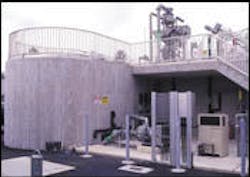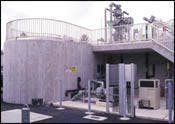Grit Removal System Handles Fine Sand
By Eric Parkes
A new design in headworks grit removal has proven effective in removing fine sand and grit from wastewater. For years, the coastal town of Florence, OR, population 5,162, had a wastewater treatment plant that provided basic treatment. In a recent upgrade of the plant, adaptability to varied flows, ease of maintenance, odor control, long-term capacity and plant effluent quality were major considerations.
Florence is a close-knit coastal resort community next to the Oregon Dunes National Recreation Area. The fine sand from this area infiltrates the wastewater collection system in large quantities. The vacation and fishing community has a large number of restaurants, hotels, golf courses, and seasonal vacationers to produce widely varying flow rates and large amounts of oil and grease.
This posed a challenge in designing the grit removal system. The system had to capture the fine sand, then classify and dewater it. Florence installed two Teacup centrifugal grit classifiers in 1982 to remove sand from wastewater prior to treatment in its lagoon. The two units each were installed with a static screen to provide non-mechanical screening and grit removal. For years, these systems performed well, operated reliably and required minimal maintenance. For the next generation of its plant, the city wanted to have a state-of the art system that would provide sufficient capacity to handle growth and anticipated discharge requirements for the next 20 years. They returned to Eutek® Systems for a solution.
System upgrade
Conventional vortex paddle-driven grit systems were considered, but they lacked the ability to capture fine grit as small as 150 microns, which was an important consideration. Screw classifiers that are usually used with the vortex paddle-driven grit systems also fail to capture fine material and do not discriminate between organic and inorganic solids. Additionally, the varying plant flow rates and the initial low flows were best suited to a system that could perform at widely varying flows.
The recently developed Headcell turned out to be the best solution. The Headcell is a modular, multiple-tray settleable solids concentrator that captures grit as small as 50 microns with minimal headloss. It is equipped with a flow distribution header that evenly distributes screened wastewater onto multiple conical trays. Tangential feed establishes a vortex flow pattern where solids settle into a boundary layer on each tray, and are swept down to the center underflow collection chamber. This system has the capability of capturing fine particles due to a large settling surface area and short settling distances.
The concentrator occupies the same space as a conventional vortex paddle-driven system, but with better performance and without any moving parts inside the unit. It effectively multiplies the surface area of a given chamber and increases its grit capture capability without an increase in footprint. The unit operates effectively at flow rates that vary from 0.5 mgd to 6.9 mgd.
The expanded plant is designed for 2.5 mgd average dry weather flow, 6.2 mgd peak day wet weather flow and 6.9 mgd peak hydraulic capacity. It currently operates between 0.5 mgd and 1.5 mgd. The new headworks includes a septage receiving station, fine screen system with ¼ inch perforated openings, and the Headcell system. Activated sludge treatment includes two fine-bubble aeration basins, two clarifiers, filtration and ultra-violet disinfection prior to discharge into the Siuslaw River bay.
The settled solids captured by the Headcell are continuously pumped to a Slurrycup and Grit Snail grit separation, classification and dewatering system. The equipment was started up in February 2000 and is as follows:
- A Headcell settleable solids concentrator containing an eight tray stack of 6 ft. diameter trays, enclosed in an above-ground concrete tank.
- A 24 inch Slurrycup Solids Classifier sized for capture of a 50 micron sand equivalent size (SES) particles at flow rates of 190-250 gpm.
- A one cubic yard per hour Grit Snail dewatering unit with a 48 in. square clarifier.
Testing
Since the Headcell was a new product on the market, the city and its engineering firm, Brown and Caldwell, required that the system be tested to verify performance after installation to prove its grit removal capability. The test was to be conducted after the system had been in service for at least six months. This was done to prove that the design would process screened wastewater without fouling, clogging or frequent maintenance. Testing was performed in April 2001 after 15 months of continuous operation.
The system is designed to remove 95 percent of all grit 150 microns inclusive and larger, at peak plant flows. The dewatered grit is to have less than 20 percent unattached organic solids and at least 60 percent total solids.
The system is also to have low headloss. To test headloss and determine performance at high flows, high flow had to be created with an eductor pumping system designed by Eutek. The city collection system could not accept a surcharge of water into its pumping stations or provide the high flows.
Fine silica sand was introduced into the system during high flows. A mass balance was run to account for all of the sand and determine the capture efficiency of the system.
Results
Performance test results on the first Headcell grit system were released in June 2001. Performance testing demonstrated that the system would remove 99 percent of grit 150 micron (100 mesh) and larger, exceeding its performance guarantee of 95 percent removal. The headloss was less than 10 inches at peak plant flow.
The accompanying Slurrycup and Grit Snail effectively washed and dewatered the solids captured by the grit removal system. The washed and dewatered grit was tested for total solids (TS) per Standard Methods 2540B and volatile solids (VS) per Standard Methods 2540E. The test results showed that the grit had 61.6 percent TS and only 9.7 percent VS, which exceeded expectations of 60 percent TS and 15 percent VS. The cleaner grit generates fewer odor complaints and occupies less volume, resulting in lower hauling costs.
The new grit removal system has been operating in Florence since February 2000. The system remains in continuous operation with no increase in headloss or stoppage of flow. Maintenance has been minimal and the system continues to remove fine grit.
Eric Parkes is Engineering Manager for Eutek Systems Inc. For more information, or a copy of the test report, contact the company at 503-615-8130 or at [email protected].
Booth 4663

